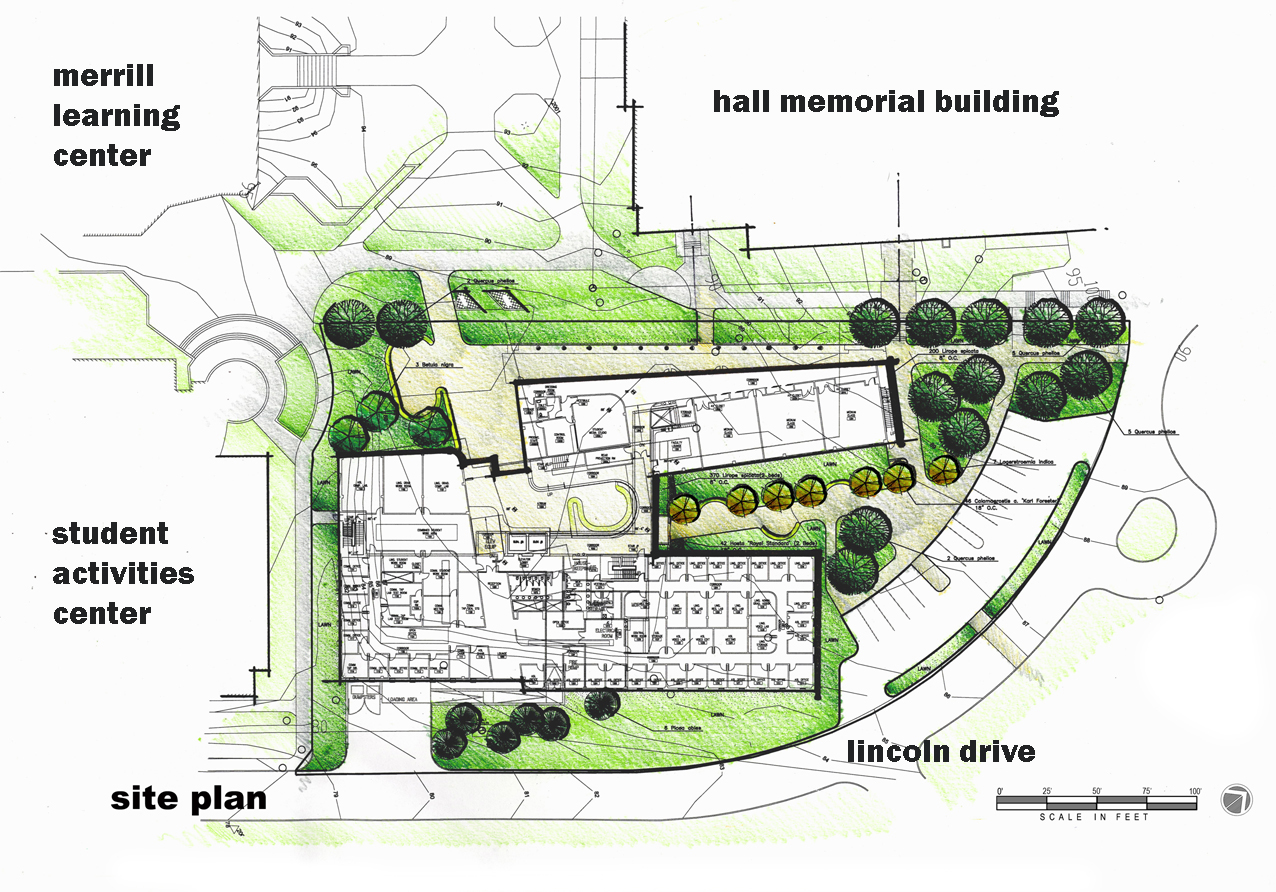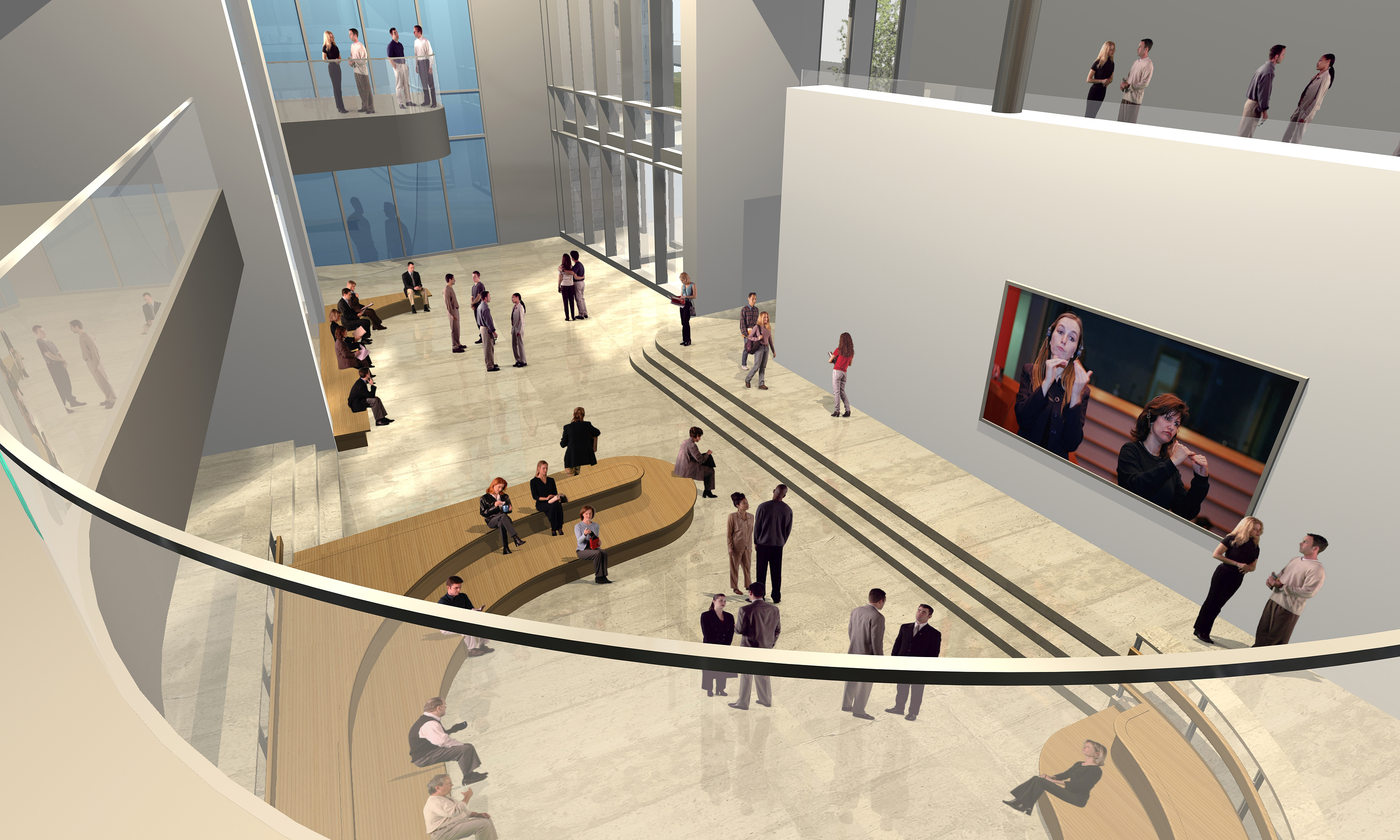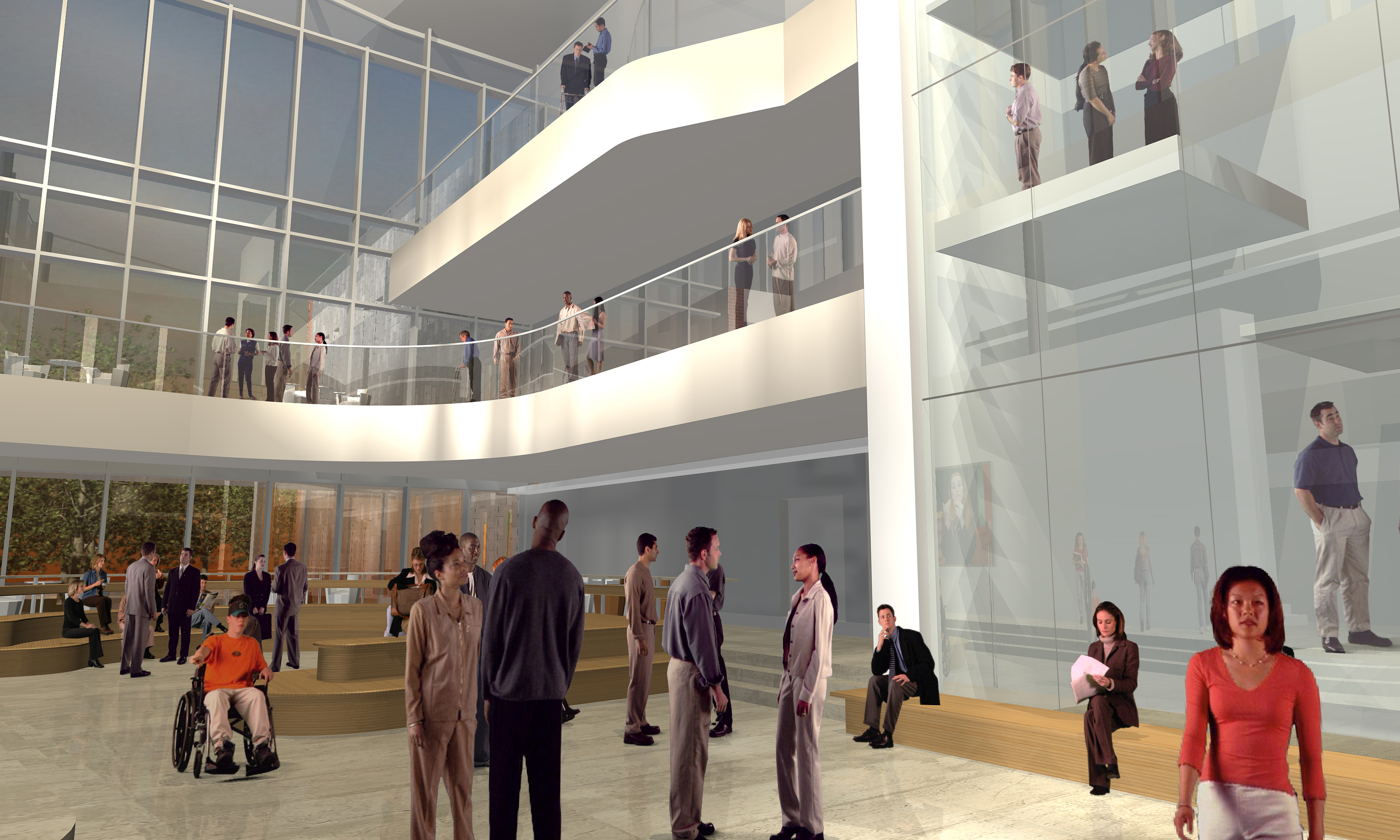Building Statistics Summary
GENERAL BUILDING DATA
| Building Name: | Gallaudet University James Lee Sorenson | |
| Language and Communication Center (SLCC) | ||
| Location: | Gallaudet University | |
| 800 Florida Avenue, NE | ||
| Washington, DC 20006 | ||
| Site: | The site is located in the heart of the Gallaudet campus and is defined by Lincoln Drive to the north and east, the Student Activities Center to the south, and Hall Memorial Building and Merrill Learning Center to the west. It is currently occupied by a dirt and gravel parking lot. The proposed main entrance is oriented west towards the center of campus. |
|
|
||
| SLCC Site Plan | ||
| Building Occupants: | Gallaudet University’s Departments of ASL and Deaf Studies; Communication Studies; Government and History; Hearing, Speech and Language Sciences; Linguistics; and Sociology. |
|
| Occupancy/Function: | B – Business, A-3 – Assembly |
|
Higher Education, Offices, and Clinical/Research Laboratories. |
||
| Size: | 88,000 sq. ft. |
|
| Levels Above / Below Grade: | 3 stories / 4 stories | |
| Project Team: | Gallaudet University | |
General Contractor: |
TBD | |
| Construction Manager: | Heery International | |
| Architects: | SmithGroup, Inc. (Primary) | |
| Kuhn Riddle Architects (Associate) | ||
Engineers: |
SmithGroup, Inc. (MEP) | |
| Edwards and Kelcey (Civil) | ||
| McMullan and Associates (Structural) | ||
| Cavanaugh Tocci Associates (Acoustics) | ||
| Technology Design Resources LLC (A/V) | ||
Specifications: |
Heller and Metzger, PC | |
Code Compliance: |
The Protection Engineering Group | |
| Dates of Construction: | Currently bidding, expected completion in 2008. | |
| Cost: | $24,054,006 (This is a construction cost estimate. Bidding is under way.) |
|
| Delivery Method: | Design – Bid – Build |
|
|
||
| ARCHITECTURE | ||
| Architectural Design: | SmithGroup has designed the SLCC to be a postmodernist addition to the Gallaudet University Campus. Drawing on elements from the surrounding historic buildings – particularly the university’s hallmark Chapel Hall – the SLCC attempts to blend into campus with a two-story, colonnaded classroom wing. A prominent atrium with two main entrances serves as a beacon, gathering space, and circulation space for occupants and visitors. |
|
|
||
| The collonaded classroom wing of the SLCC reflects the Collonade of the historic Chapel Hall across the campus green. | ||
The design adapts to the “visu-centric” way of being within the deaf culture. Vibrant colors and bold text and signage direct occupants throughout the building. Perimeter walls of the atrium will be configured to maximize transparency, visually connecting the atrium with the surrounding spaces. A Deaf History Time Line will feature prominently in the atrium exhibiting milestones within the history of the deaf culture. The proposed new facility is configured in an articulated rectangular plan arranged around a central enclosed atrium. The south and east corners of the rectangle form a three-story ‘L’ shaped structure housing faculty offices, computer labs, audiology research spaces, and support spaces. The western side of the atrium features a two-story bar extending north. This portion of the SLCC houses classrooms, conference rooms and multi-purpose spaces. |
||
|
||
| The atrium space of the SLCC. | ||
| Code Compliance: | District of Columbia Building Code, Supplement 2003 |
|
| IBC 2000 IFC 2000 IECC 2000 | ||
IPC 2000 IMC 2000 NFPA NEC 1996 |
||
| Zoning: | R-4 | |
| Building Envelope: (Walls) | Above grade masonry exterior walls will be constructed with brick masonry supported on steel relieving angles with EPDM flashing. The masonry façades feature both smooth and rough face brick. Several windows on the south and east façades are encased in precast concrete window surrounds. A portion of the south west façade features metal panel exterior walls constructed with an insulated metal panel system and finished with a randomized Floropon finish. The glass curtainwall of the atrium will include 7 ½” extruded aluminum mullions with 1” insulated low-e glazing units. A vertical PVC fabric sunshading system will be attached to vertical mullions on the western façade. Below grade masonry walls will be constructed with ground face concrete masonry units over a cast-in-place concrete wall. A self-adhering waterproofing membrane sheet will be applied with a perforated drainage board. |
|
| Building Envelope: (Roofs) | Flat roofs will consist of flat plate concrete slabs with a fluid applied IRMA roof system over the concrete deck. Four inches (4”) of rigid insulation, filter fabric, and river washed gravel ballast will be applied above the membrane. The deck will be sloped towards roof drains. The sloped metal roof over the atrium will be constructed of a standing seem painted steel roof system over a sheet applied roof membrane and roof sheathing. |
|
| ENGINEERING: | PRIMARY SYSTEMS | |
| Mechanical System: | The SLCC is served by six (6) Trane M-Series Climate Changer Air Handing Units (AHU). Each unit serves a distinct zone within the facility that is unique in use and occupation schedule. The spaces served include classrooms, offices, conference rooms, computer labs, media studios, therapy rooms, audiology labs, and typical support spaces. In total, the AHUs are designed to provide 72,875 CFM of conditioned air (53.7°F DBT, 100%RH cooling, 40°F-60°F DBT heating) to 142 terminal VAV units. 21,360 CFM – or about 30% – of this supply is outdoor air. AHUs use hot water coils for heating and chilled water coils for cooling and dehumidification, and reheat at the terminal units is also provided by hot water. Additionally, several spaces are conditioned without service from these AHUs. For example, the Computer Server Room on the third floor is conditioned by a Liebert Computer Room Air Conditioning (CRAC) Unit and mechanical rooms in the basement are heated by Trane Hot Water Unit Heaters (UH). Trane Fan Coil Units (FCU) are employed in support spaces, Trane Electric Unit Heaters (CUH) are used in stairwells, and Vulcan Finned Tube Radiators (FT) serve the balconies of the atrium. Since the SLCC is on a university campus it does not contain plants to produce either steam or chilled water. Instead, centralized steam and chilled water service – as well as potable water distribution – is provided from the Central Utilities Building. High Pressure Steam (HPS) from the Central Utilities Building passes through a Pressure Reducing Valve (PRV) that reduces steam pressure from 100 psig to 15 psig. Then steam is directed to a Spirax Plate and Frame Heat Exchanger that provides 280 gpm of 180°F hot water for use in hot water coils. Chilled Water is directly provided to the cooling coils at 43°F. |
|
| Structural System: | The above grade structural system of the SLCC is primarily composed of structural steel columns and beams with open web trusses. Above grade floors are composed of composite light weight concrete floor slabs on a composite metal decking and are supported by the open web trusses. Typical beam sizes range from the W21 series to W24. However, many smaller beam sizes – as low as W10 – are used throughout the building because of its varying geometry. Column sizes range from W10 to W12 series, and also include square Hollow Structural Steel (HSS) columns when exposed. The lateral force resisting system of the SLCC is a combination of braced frames and moment connections. The foundation system of the SLCC consists of concrete caissons ranging from 30 in. to 72 in. in diameter that support perimeter grade beams. The basement floor is composed of a 6 in. reinforced concrete slab on grade, while above grade floors not above basement rooms are 5 in. reinforced concrete slabs on grade. Foundation walls are typically 12 in. reinforced concrete walls. |
|
| Electrical System: | Electrical service is distributed from the utility throughout campus via the Central Utilities Building. Power for the SLCC is taped from under Lincoln Circle Street and directed to a 15KV-480/277V, 3 phase, 4 wire pad mounted transformer located adjacent to the new building. From here, a ductbank leads to the main electrical room in the basement and feeds a 480/277V, 3 phase, 4 wire, 2000A switchboard. Power distribution within the building consists of a vertical riser beginning in the main electrical room in the basement and rising through stacked electrical closets up to the third floor. Closets on each floor contain a 480V panelboard for lighting and mechanical loads, a 480-120/208V transformer, and 120/208V panelboards for receptacle loads. Emergency power is provided by a 300KW diesel generator. 480/277V, 3 phase, 4 wire emergency power is directed to three automatic switches; one is for life safety loads such as fire alarms and egress lighting, one for elevator power, and one for miscellaneous emergency loads. |
|
| Lighting: | The deaf community relies on visual communication much more than the non-deaf population. Therefore the SLCC is designed to adapt to this “visu-centric” way of being. Lighting is notably important in this goal, and the lighting design of the SLCC includes unique features to address it. Lighting in typical classrooms, offices, etc. is provided by a variety of indirect pendant fluorescent luminaries and fluorescent downlights with control by occupancy sensors with manual override switches. Hallway illumination is typically indirect fluorescent cove lighting with control by the building management system. Emergency lighting is provided with a pattern of fluorescent linear lights in public areas and LED type wall/ceiling mounted exit signs. Lighting levels are based on IESNA recommendations for footcandles on working surfaces and walls with some additional lighting to improve sign language communication. A unique space within the SLCC is the Student Media Studio. Here theatrical lighting is required to meet video requirements as well as recessed fluorescent fixtures for general lighting. Also, all spaces without portal windows in the doors will be equipped with visual doorbells. These devices turn off lights above doorways when the doorbell is pressed. Exterior lighting is intended to draw visitors towards the central atrium and to highlight the varying textures of the façade. The frequency and brightness of lighting – from both exterior and interior illumination – increases with proximity to the main atrium entrances. Also, the brightest part of the SLCC is the focal atrium. Metal halide downlights illuminate the pathways leading to the entrances and metal halide in-grade grazing uplights highlight the texture of the brick façade. |
|
| Plumbing: | One major design goal of the SLCC is to reduce water use by 30%. In order to do this, design elements include waterless urinals, dual-flush toilets, and automatic sensors on sinks. Domestic water service will be provided from a street main with a backflow protection device and booster pump. Domestic hot water will be produced in a dual coil steam/electric water heater with a 225 gal capacity. All waste will drain to street sanitary sewer systems. Storm water will be drained directly from the roof through the building and directed to street storm drains. |
|
| Construction Management : | The SLCC will be delivered to the owners at Gallaudet University with a design-bid-build method. The project was put out for bid in September 2006 following completion of the contract documents, but a contactor has not been selected as of November 1, 2006. The original completion date had been planned as May 2008, though it is likely that this date will be postponed. Heery International will serve as the construction manager. |
|
| ENGINEERING: | ADDITIONAL SYSTEMS | |
| Fire Protection : | A wet pipe sprinkler system will be designated for the occupied portions of the building. Classrooms and offices are classified as “Light Hazard” risk and mechanical rooms are designated as “Ordinary Hazard Group 1.” Water for this system is provided by domestic water service and distributed via a 1,000 gpm electric fire pump and 12 gpm electric jockey pump each providing 150 ft of head. These pumps are powered by the emergency power from the emergency diesel generator. Fire alarms consist of audio horns, strobes and combination devices. An annunciator panel with building graphics and an LED screen is located at the ground level east entrance to the atrium. Finally, three (3) 15,000 CFM atrium smoke exhaust fans are linked to the fire alarm system and evacuate smoke from the large atrium space. A negative pressure within the atrium draws air from the exterior and adjacent spaces, thus limiting a fire and smoke from spreading from the atrium. |
|
| Transportation: | The primary mode of vertical transportation within the SLCC is two hydraulic elevators in the atrium. These elevators are specified to be conventional 4,500 lbs. passenger elevators servicing four (4) floors. Shafts will be constructed of gypsum board on all sides but the west facing wall. This shaft wall is configured to feature glass openings in the elevator cabs. |
|
| Audio-visual System : | All meeting rooms, computer labs, and classrooms will be equipped with drop-down screen screens, projectors, and a computer interface. Additionally, classrooms and computer labs will have closed captioning devices and scanners. Classrooms will utilize SmartBoards and DVD/VCR players, and one classroom will be designated as a distance learning classroom with a plasma display and additional cameras and microphones. Cameras will be provided in clinic spaces, therapy spaces, conference rooms, and a multi-purpose room along with DVD/VCR players. | |



